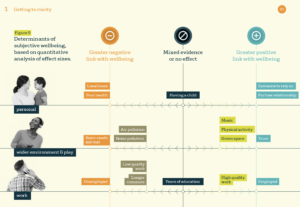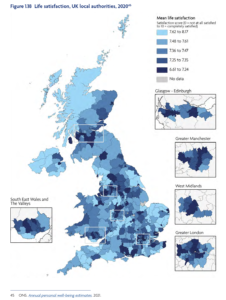Levelling up and measuring wellbeing
Yesterday, in its Levelling Up White Paper, the Government described wellbeing as
“…the extent to which people across the UK lead happy and fulfilling lives – the very essence of levelling up. It is affected by a variety of different facets of people’s lives, from physical and mental health to jobs, community relationships and wider factors that influence quality of life such as the environment. Consequently, although it is intrinsically linked with human capital, well-being has a bearing on all four of the UK Government’s objectives for levelling up.” p.186
We believe that improving wellbeing is the ultimate goal of effective policy and community action. In this blog, Executive Director Nancy Hey shares the wellbeing highlights from the White Paper, and what it means for the Centre’s mission to improve the nation’s wellbeing.
Wellbeing in the Levelling Up White Paper
The Government has announced 12 cross-society ‘Missions’ with indicators that will be put into law with annual reporting on progress. Mission 8 directly relates to wellbeing, and subjective wellbeing metrics:
“Mission 8. By 2030, well-being will have improved in every area of the UK, with the gap between top performing and other areas closing.” Executive Summary p.7
As wellbeing is the essence of levelling up, it is integral to all 12 ‘Missions’ and is represented in indicators across the levelling up agenda.
“Taken together, these missions will help achieve the overarching ambition to improve well-being in every area of the UK, with the gap between top performing and other areas closing (Mission Eight)” Executive Summary p.12
As noted by the BBC’s Christian Fraser, “wellbeing will be by law, a metric of Government success”.
This reflects the fact that wellbeing isn’t just a ‘nice to have’ cherry on the top of other policies. But if you get the key drivers of wellbeing right – employment, education, health and environment – you improve wellbeing across the board.

What Works Wellbeing: Wellbeing Evidence at the Heart of Policy
Wellbeing analysis, measurement and indicators
The White Paper also notes an intention to:
“undertake further work to supplement existing data on wellbeing at a subnational level, as well as to understand the drivers of wellbeing and identify the most impactful levers available to policymakers.” Technical Annex p.33
And so alongside the levelling up white paper the Office for National Statistics have published indicators related to the missions at a local authority level across the UK. It is an interactive tool to explore a range of indicators that help to understand the unique strengths and opportunities of each local area and can be used to find out how local authorities compare with others across the UK.
This reflects recent changes to how the Government approaches data and evaluation, and follows the:
- HMT Budget in 2021 that highlighted regional disparities in life satisfaction.
- Green Book Supplementary Guidance in July 2021 on how to use wellbeing evidence in policy development, business cases and evaluation.
The Paper uses the WELLBYs approach to measuring wellbeing to estimate that raising the bottom 25% of places to the UK average life satisfaction score would be worth £57bn – £92bn (p.129)

Levelling Up White Paper p.25
Tracking Mission 8
To track the progress of subjective wellbeing in line with Mission 8, there are a wide range of data sources available on the four subjective wellbeing indicators – quality of life, happiness, a sense of life being worthwhile, and anxiety. Our data and analysis page provides an overview of these data.
Additionally, here are some further data sources which will be useful to this mission:
- Analysis of wellbeing metrics, surveys that include them,how to include & them in your survey and analyse findings
- Overview of last 10 years of subjective wellbeing data (including the pandemic)
- Local Area trends over last 10 years
- Public Health Outcomes Framework Fingertips
- LGA inform
- Thriving Places Index
- Who is most at risk of low wellbeing?
Resources to level up wellbeing
Over the last seven years, the What Works Centre for Wellbeing has contributed to, and advocated for accelerated research around what really works to improve people’s wellbeing across different areas of life, across all sectors and places across the UK to use in decision making. Including democratising access to the wellbeing evidence that has come out of this work.
We have also made available information and evidence about what works to understand and improve wellbeing across the 12 mission-related areas for:
- Individuals (including children and young people)
- Geographical area
- Loneliness
- Communities
- Financial
- Reducing inequalities
Useful Centre resources
- Wellbeing evidence at the heart of government. Read our report.
- What effect do different types of intervention have on personal wellbeing? Read our ONS4 rapid review assessment of impact evaluations.
- What is the impact of measuring wellbeing? Explore our guide for charities and social enterprises here.
- Evidence and resources to improve workplace wellbeing.
- Tools for measuring children and young people’s wellbeing.
